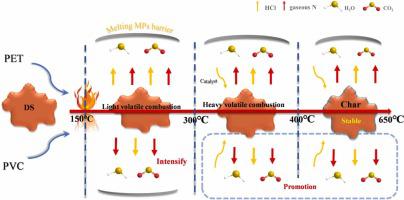Journal of Hazardous Materials ( IF 13.6 ) Pub Date : 2022-06-18 , DOI: 10.1016/j.jhazmat.2022.129394 Xiaoao Shi 1 , Jinping Li 2 , Lingna Shang 1 , Sijia Wang 1 , Si Chen 2 , Jingxin Liu 2 , Meng Mei 2 , Yongjie Xue 3 , Teng Wang 2

|
Microplastics (MPs), as emerging contaminant detected in dyeing sludge (DS), inevitably affected the subsequent treatment and disposal of DS. However, the effect of MPs on the predominant disposal path (incineration) of DS remains far from explicit. This study used thermogravimetry-mass spectrometry (TG-MS) method to explore the effect of representative MPs, polyethylene terephthalate (PET) and polyvinyl chloride (PVC), on combustion characteristics, gas evolution and kinetics on DS combustion. Results showed that PET inhibited the whole combustion of DS by physical barrier. Relatively, PVC delayed the combustion of light volatile but promoted heavy volatile and char reaction due to HCl catalyst. Generally, MPs deteriorated the combustibility, burnout performance and combustion stability of DS. MPs aggravated HCl and gaseous N emissions. Noticeably, the interactions between DS and PVC accelerated the emissions of gaseous pollutants, especially under high dose condition. DAEM and FWO models could well describe the combustion kinetic of DS containing MPs. MPs led to an increase in activation energy of DS, namely, it deteriorated the combustion efficiency of DS. The combustion mechanisms could be divided into two stages: (1) diffusion (D3) stage: melted MPs blocked the gas channels, (2) chemical reaction (F3): the residual chars were thermally stable.
中文翻译:

染色污泥中的微塑料:它们是否会影响污泥焚烧?
微塑料(MPs)作为染色污泥(DS)中检测到的新兴污染物,不可避免地影响了DS的后续处理和处置。然而,MPs 对 DS 的主要处置途径(焚化)的影响仍远未明确。本研究采用热重-质谱 (TG-MS) 方法探讨代表性 MP、聚对苯二甲酸乙二醇酯 (PET) 和聚氯乙烯 (PVC) 对 DS 燃烧的燃烧特性、气体逸出和动力学的影响。结果表明,PET通过物理屏障抑制了DS的整个燃烧。相对而言,PVC由于HCl催化剂的作用,延迟了轻挥发物的燃烧,但促进了重挥发物和炭化反应。一般来说,MPs 会降低 DS 的可燃性、燃尽性能和燃烧稳定性。MPs 加剧了 HCl 和气态氮的排放。值得注意的是,DS 和 PVC 之间的相互作用加速了气态污染物的排放,尤其是在高剂量条件下。DAEM 和 FWO 模型可以很好地描述含有 MP 的 DS 的燃烧动力学。MPs导致DS的活化能增加,即降低了DS的燃烧效率。燃烧机制可分为两个阶段:(1)扩散(D3 )阶段:熔化的MPs阻塞了气体通道,(2)化学反应(F 3 ):残余的炭是热稳定的。


























 京公网安备 11010802027423号
京公网安备 11010802027423号